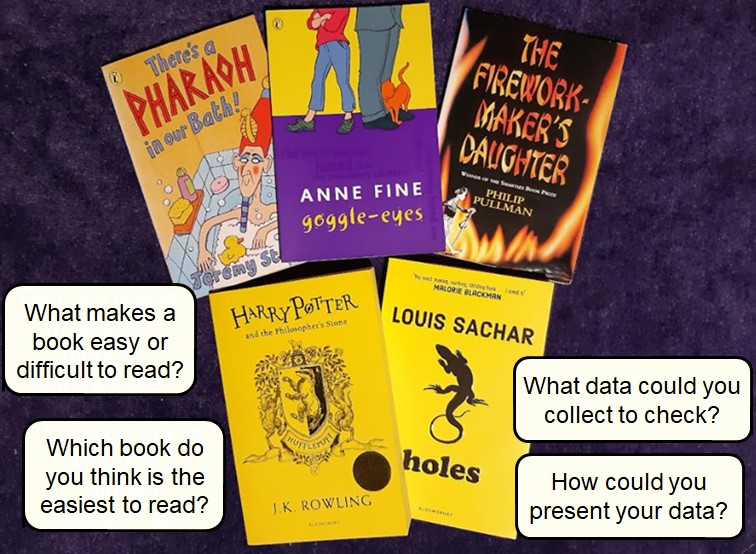Which book is most difficult?

This investigation involves exploring the difficulty level of books by collecting, representing and interpreting data, including finding the mean and range.
What you will need
Initial discussion
Show the books.
Which you think will be the easiest/most difficult to read? Why? What do you think makes this book the easiest/most difficult?
Encourage thinking about elements of the text (e.g. the length of words or sentences, how many words or sentences on a page/in a paragraph). Record the ideas shared.
How could we use your ideas to determine the difficulty level of these books?
Record the ideas (e.g. counting how many words in a paragraph/on a page in each book, etc).
Will it matter which page we choose?
Show 2 different pages of the same book which have a different amount of text (e.g. a full page and a part page at the end of a chapter or where there is a lot of dialogue).
How can we get a true reflection of the overall difficulty if it varies from page to page?
Discuss examining more than one page/paragraph to find the mean or the range.
How will you collect and represent your data?
Share and record ideas (e.g. tally charts, tables, bar charts etc).
The investigation
Children work in pairs or small groups. They decide on the criteria they will collect (e.g. word length) and choose 3 or more books which they estimate to be of different difficulty levels. They predict the difficulty order of their chosen books. They then decide how to collect their data and how many times they will do so (e.g. collecting the number of letters in each of the first word on a page and repeating this 10 times, the number of sentences on a page/in a paragraph and repeating this 10 times etc). They collect and record the data, then find the mean/range. They repeat this for each book before deciding on a format to represent their data clearly.
Evaluation
Children share their data representation, explaining their data collection process and whether their findings matched their initial predictions. Encourage reflection on the process and evaluation of their data and representation.
What did you do that worked well?
Did anything in your data surprise you? Why do you think this was?
Variation for younger children:
Introduce the activity by showing 2 picture books and asking if they think one would be easier to read than the other.
Why do you think it would be easier? Which do you think would have more words?
Model counting the words on a page. Represent this on the axes drawn for a bar chart/pictogram by colouring in squares or sticking on spots/paper squares etc. Decide how many pages to check. Children then take turns to count the words and record on the chart. Evaluate the data recorded.
What is the fewest/most number of words on a page? How many pages have less than 10 words?
Give each child, or pair of children, a sheet with the axes recorded for the chosen number of pages. They choose a book, then count and record how many words on each page, representing their data in the agreed format.
Children share their representations.
Which book had the most/least words on a page?
Which book has the most pages with more than ten words?
Which book do you think would easiest/most difficult?
Is there anything else that would make a book easier/more difficult?
 Facebook
Facebook
 Instagram
Instagram